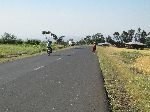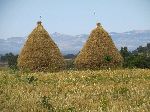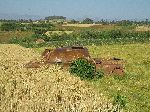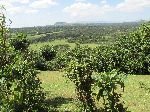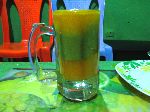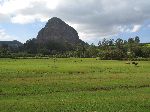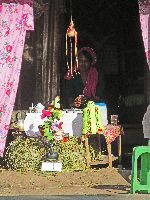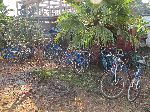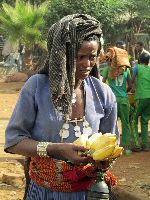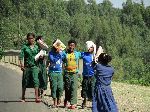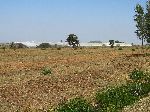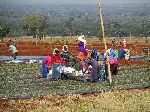| Ethiopia:
Abyssinia Adventure - Hwy 3 Agew - Awi National Zone Bicycle Africa / Ibike Tours |
|||
 |
Agew Awi is one of 10 Zones in the Amhara Region of Ethiopia. Agew Awi is named for the Awi sub-group of the Agaw people, some of whom live in this Zone. Agaw is one of more that 80 languages spoken in Ethiopia. There are a million Agaw speakers. The Agaw have traditionally practiced a land-management system that is well adapted to the local ecology, enabling them to sustain the fertility of the soil and minimize erosion. This area is recognized as one of the most productive in the Amhara Region. The section along the road runs from 2400m to 2000m in elevation, generally sloping down from south to north. |
||
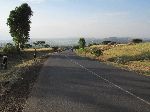 |
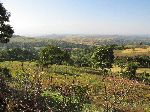 Immediately
out of Bure, Highway 3 climbs about 500 meters in ten kilometers over the west end of Mengistiwo ridge,
with a high point of 2565m. In the morning air it was a nice climb with an
expansive view. Immediately
out of Bure, Highway 3 climbs about 500 meters in ten kilometers over the west end of Mengistiwo ridge,
with a high point of 2565m. In the morning air it was a nice climb with an
expansive view.It appears that things haven't gone so well on the hill; along the flotsam and jetsam of other stalled vehicles, there are three large blocks of marble (left) that must have fallen off a truck. They look like they should have considerable value, but maybe not enough to send out the heavy equipment that would be needed to retrieve them. At the top of the hill is a derelict tank (left), likely dating from the civil war. This and other passes between northern and southern Ethiopia were strategic ground and many battles took place around them. The value of such war relics may not be sufficient to justify the expense of pulling them out and recycling them. One lesson the tank demonstrates is the practice of rotational farming. In 2014 (upper right), wheat in the field that the tank is in. In 2015 (lower right) the field is left fallow and the tank is surrounded by weeds. |
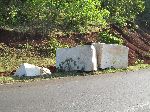 |
|
 [Graphs are built with incomplete data and are only general representations of the topography.] |
|||
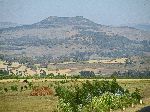 |
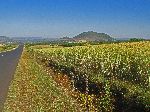 Up
on
the ridge the scenery included volcanic
relics: lava plugs, cinder cones and crater lakes dotted
the landscape. Some of them line up in rows and others are strangely
isolated. In all of the combinations they add new drama to the countryside. Up
on
the ridge the scenery included volcanic
relics: lava plugs, cinder cones and crater lakes dotted
the landscape. Some of them line up in rows and others are strangely
isolated. In all of the combinations they add new drama to the countryside.This day is developing to be the best day so far. |
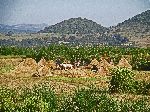 |
|

|
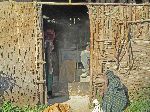 In the fields along the road people were using animals
to process their harvest
(left). The horses walk around in circles to knock the grain off the
stalks. In the fields along the road people were using animals
to process their harvest
(left). The horses walk around in circles to knock the grain off the
stalks.The grain can then be taken to the mills (right), in the towns, where it is ground into flour. At the far right are a couple of
camouflaged hornbills. There are two birds in the photo. |
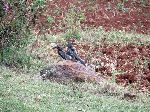 |
|
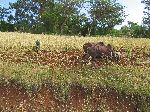 |
Additional scenes from the agricultural countryside are; farmers turning their field with a traditional plow pulled by ox. And a donkey and cart, with the cart laddened with hay. |
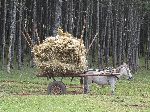 |
|
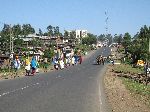 |
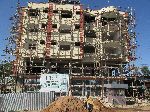 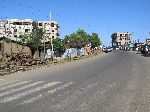 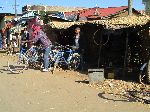 Things
seem to be going well in Tilili (2400m) where new multi-story
buildings look like a sign that it is starting to prosper. Most of the town's commercial district has a typical small town
look (as with the bicycle shop on the right), but the new construction gives
the impression that it is in the process of becoming something bigger.
Simultaneous, the traditional weekly market is a thriving sea of humanity
(right). Things
seem to be going well in Tilili (2400m) where new multi-story
buildings look like a sign that it is starting to prosper. Most of the town's commercial district has a typical small town
look (as with the bicycle shop on the right), but the new construction gives
the impression that it is in the process of becoming something bigger.
Simultaneous, the traditional weekly market is a thriving sea of humanity
(right). |
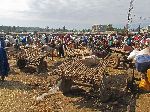 |
|
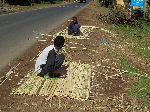 |
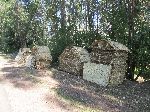 Everyone
in Tilli seems to be in constant motion -- carrying something, weaving mats,
making furniture, preparing grain, cleaning, etc. No one was
sitting around doing nothing; in fact, everyone was so busy our arrival and
presence was largely ignored. As we took pictures people might look up, but
generally they didn't stop what they were doing. Everyone
in Tilli seems to be in constant motion -- carrying something, weaving mats,
making furniture, preparing grain, cleaning, etc. No one was
sitting around doing nothing; in fact, everyone was so busy our arrival and
presence was largely ignored. As we took pictures people might look up, but
generally they didn't stop what they were doing. |
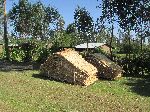 |
|
 |
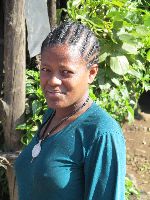 Hard
working, industrious, and purposeful are words that come to mind. These are
also words that are often ascribed to the Awi ethnic group that lives in the
area. In fact they have their own political jurisdiction, the Awi
National Zone. Hard
working, industrious, and purposeful are words that come to mind. These are
also words that are often ascribed to the Awi ethnic group that lives in the
area. In fact they have their own political jurisdiction, the Awi
National Zone.The zone has it own social service programs, education office, teacher training college, and other capacity building initiatives. It is also a "green culture", in that shades of green are clearly the preferred color for clothing among the people here, especially women. And clothing that is not green often seems to be dominated by red. |
 |
|
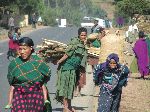 |
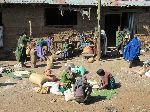 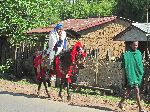
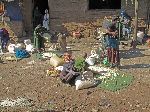
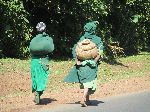 |
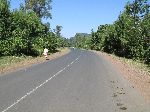 |
|
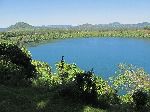 |
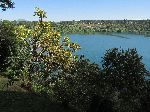 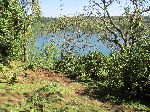 Lake Zengena is the second
deepest lake in Ethiopia next to Lake Shalla, with a maximum depth of 166m
followed by Tirba, with amaximum depth of 153m. The diameter of the lake is roughly
1 km. Zengena is a closed lake in that water flows in but there is no
outlet. There is an ongoing effort to control activities in and around the
lake so the water flowing into it doesn't
become polluted. Lake Zengena is the second
deepest lake in Ethiopia next to Lake Shalla, with a maximum depth of 166m
followed by Tirba, with amaximum depth of 153m. The diameter of the lake is roughly
1 km. Zengena is a closed lake in that water flows in but there is no
outlet. There is an ongoing effort to control activities in and around the
lake so the water flowing into it doesn't
become polluted.The lake is a draw for tourists, largely Western birders
and Ethiopians picnickers . This is reflected in the souvenir stand
at the foot of the trail leading to the lake. |
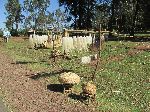 |
|
 |
Honey collecting is one of the activities around the lake. For the connoisseur there are two different types of beehive construction in the same area; both were about the same size, but one was made by bundling grass stalks together and the other was more of a woven tube. |
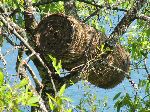 |
|
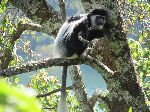 |
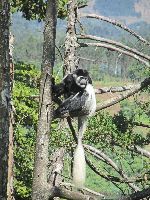 The charismatic mega-fauna at the lake are Black and White Colobus monkeys. I am not sure if they
find humans to be charismatic mega-fauna as well, but they can be as engaged
watching us as we are watching them. The charismatic mega-fauna at the lake are Black and White Colobus monkeys. I am not sure if they
find humans to be charismatic mega-fauna as well, but they can be as engaged
watching us as we are watching them.
More likely to be heard than seen are African fish eagles. Even if you see them, they tend to be hard to photograph. The fish eagles find the trees ideal perches for watching the lake, in hopes of spotting their next meal. There are numerous other birds in the forest around the lake, but all seem to be easier to hear than to see. |
 |
|
| We had been told that the local specialty in Injibara (2550m) is gusguso, an Agaw version of shero with cheese in it, but most of the people working in the restaurants were not Agaw and had never heard of it. Even in the rare cases that someone seemed to recognize the name, we couldn't find anyone who was serving it. The absence of cheese seems to be a majoy stumbling block. [A subsequent Internet search for gusguso, and shero with cheese, produced no hits.] |
 |
||
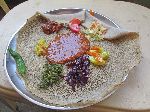
|
On the subject of food: The month before
major holidays like Christmas and Easter are "fasting" periods. It is a fast
from meat so bayeynetu (injera with 6-10 vegetarian dishes) is more readily
available (left and right).
Referring to the photos below, left to right, counterclockwise: A popular breakfast is foul, a tasty lentil dish generally served with bread. It is similar to Indian dal. Variations can be found from the Levant, down through Arabia, the Red Sea and through out the Horn of Africa. If you order 'special foul' it comes with scrambled eggs, yogurt and extra onions, and is even tastier. In better restaurants, on the breakfast menu you can find fetira (sort of a pancake with egg, honey or butter) and chechebsa (strips of fried flat bread mixed with cumin, pepper and other spices). Presumably everything is nicely paired with the telai (local beer). Coffee and tea are more readily available the telai. Even in the smallest village there is often an element of art and elegance in the way the jebena is tipped and the presentation of coffee. The most common tea is flavored with cinnamon, but ginger tea is frequently available. The coffee and teas are drunk very sweet. Another home-brew is tej, honey wine or mead, usually served in a berele, a round glass flask or beaker. Leaves and twig are added in the fermentation process to give it a bit of a smoky flavor. It is very sweet. Pure fruit smoothies are commonly available in papaya, avocado and mango. A glass of all three is a 'spites'. |
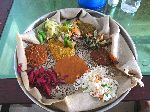
|
|
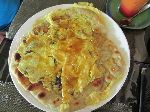 |
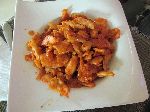
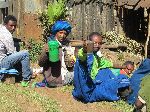
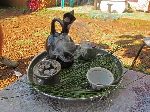
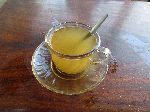 |
 |
|
 |
Injibara is the largest town in the Agaw Awi National Zone. Within the long commercial strip there is a beautiful Mikeale Orthodox Church (left), lots of stores selling ready-made western-style clothes, and a large billboard featuring four women, each holding a condom. All of the script on the billboard is in Amharic so I can't relay the precise message, but the logos at the bottom include USAID. Presumably it's part of a safe-sex and HIV prevention campaign. |
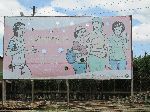 |
|
|
|

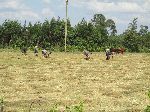

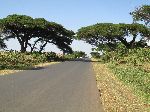 After Injibara the road begins to descend, with a corresponding change in micro-climate. |
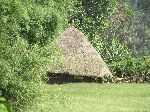
|
|
Dangla or Danglia
(2120m) might be the second largest town in the Agaw Awi National Zone. It
is hard to judge Dangla because there are two separate pieces to it.
There is an old town that is completely off the highway and there is a new
town that is developing as a strip city along the highway. The older
section has streets of one-story shops with lots of variety (dry goods,
tailors, hardware, butchers, home furnishings, etc), catering to
the local population.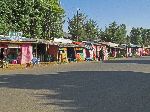 The new section has several multi-story hotels, banks, phone stores, and a long, unique row of purposefully decorated, roadside coffee stalls, where the dominant color is pink. This section is much more oriented to the traffic that is using the highway. Though there wasn't a lot of local bicycle riding to be seen when we were on the street, there is a local bicycle shop and bicycle rental business in Dangla (right). The combination of energetic people and the diverse and a scenic natural
environment made the Agaw Awi National Zone the best day so far. |
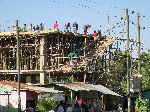 |
||
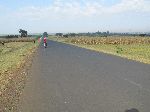
|
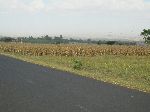
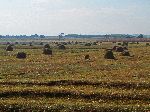
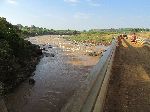
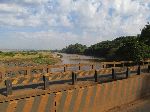 North
of Dangla, Highway 3 is relatively flat. The elevation drops 1900m to
2000m and we are back into the corn belt. The Gilgel Abay River still had
some water in it, but not likely enough to sustain much agricultural irrigation |
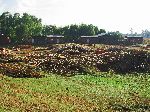 |
|
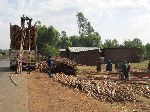 There
are also large tracts of land, with Eucalyptus forest and associated
harvesting activities. The harvesting must be well managed because we saw
several depots of poles waiting to be bought and carried to another market,
but there weren't any sections of clear cut forests. When the buyers arrive
with their trucks, they stack the load high. There
are also large tracts of land, with Eucalyptus forest and associated
harvesting activities. The harvesting must be well managed because we saw
several depots of poles waiting to be bought and carried to another market,
but there weren't any sections of clear cut forests. When the buyers arrive
with their trucks, they stack the load high.Whether the whole forestry is sustainable is an open question: eucalyptus has a huge need for water and a deep taproot, so even if the area is drought-prone, the tree can reach down into the water table and start drinking. If there are enough eucalyptus trees, over time, they can drink the water table dry Consistent with other woodlot areas, the donkey carts hauling bags of
charcoal (far right) indicate that the cottage industry is near by. |
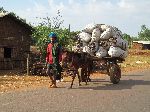 |
||
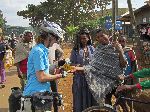 A stop for a snack in Merawi led to the purchase of some bananas.
A stop for a snack in Merawi led to the purchase of some bananas.Among the crowd that gathered around were some students and a teacher. From a short chat we learned a little about each others' lives. There were more bicycles out on the roads in and around town where the terrain is flatter. This increased ridership might be the explanation for the bike wash business down at the stream at the edge of town. The bike was being thoroughly scrubbed and was in deep enough to have its hubs, bottom bracket and chain submerged -- a questionable practice. |
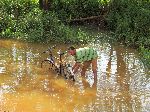 |
||

|
To add to our sense that we
were finding a little bike culture, a
group of bicycle racers on a training ride passed us in Merawi. They didn't seem
to be from the town itself. An hour or so
later they whizzed by us again on their way north, well outside of Merawi, and probably heading to Bahir Dar,
which was likely their starting point. I wouldn't be surprised if they
went most of the way to Dangla before they turned around. It made us feel
like we were standing still. The roadside scenes continued to be continually changing and engaging: |
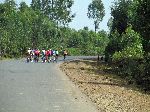 |
|
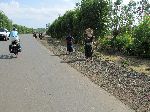 |
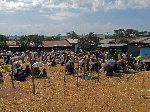
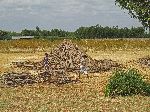
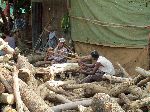
 |
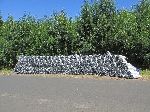 |
|
|
People were carrying various parcels and loads, there was a market in a town
square, men were stacking poles in preparation for making charcoal, men were
sawing planks by hand, nearby the wood was being used to make furniture, and
bags of finished charcoal were stack by the side of the road, waiting for buy in
trucks to purchase it and haul it to the cities. |
|
||
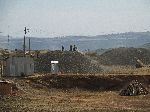
|
The stockpiling of
construction materials can still be very labor intensive -- labor is cheaper
than capital equipment. In places men sit with sledge hammers and pound away on rocks
until they are turned into gravel. Here (left) women are carrying baskets
filled with gravel to the top of a pile and pouring them out to build up the pile.
|
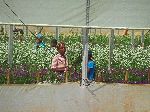 |
|
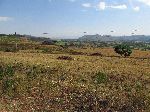 |
The low hills surrounding much of Lake Tana makes it look like it sits in a large basin, but the surface is still almost 1800m above sea level. Lake Tana is the largest lake in Ethiopia, and one of the largest lakes in Africa. It is approximately 84 kilometers long and 66 kilometers wide, with a maximum depth of 15 meters. It supports a fishing industry, and Bahir Dar, at the southeast corner is a hub of tourism. |
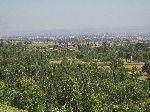 |
|
|
|
|||
|
|
Unique Programs To Special Places For Memories Of A Lifetime!
"Hosted by
DreamHost - earth friendly web hosting"
|
|
